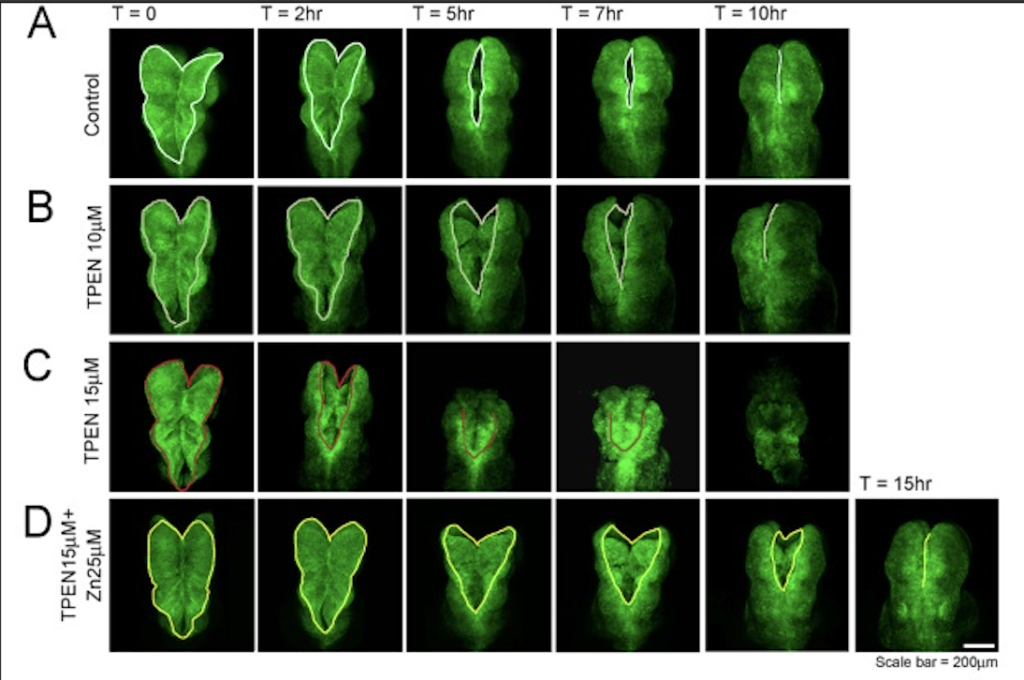Zinc is one of the most crucial metals required for physiologic function in the body. Most of the zinc in the human body comes from dietary intake from things like chicken, red meat, beans, oysters, … etc. Zinc deficiency arrests cell growth and development, it also leads to chaos in the system. Excess of zinc can become toxic if not maintained well in the cell. Zinc in the body has three functions categorized as catalytic, structural or regulatory [1].
One of zinc’s functions in the body is acting as a catalytic that can increase the reactivity of substrates. 100’s of enzymes rely on zinc for catalytic activity and studies have shown that removal of zinc on some proteins leads to a loss of activity while its reconstitution usually restores function [1]. One of the most important proteins where this can be seen is RNA polymerase[2]. A study was done that split RNA pol into its different subunits, α β, and β’, and tested the effect of zinc on each subunit to see if the metal has any effect on overall polymerase activity (Fig. 1).
Another one of zinc’s functions in the body is to provide structure and stability to proteins. One of these proteins is copper-zinc superoxide dismutase. This protein has two metals to contribute to its function. Here, copper is used as a catalyst, and zinc is used for stability. The protein creates finger-like motifs that protrude from its structure and create an environment to host the metal, in this case the zinc.
These finger-like motifs are usually made of cysteine and histidine side chains and they bind to zinc ultimately giving the whole protein stability and structure. The removal of zinc in proteins that use it for stability will decrease function but not inhibit it. This illustrates zinc’s structural function as it increases function and its absence does not fully eliminate function.
The last function of zinc is a regulatory function. This function of zinc isn’t very well researched and is still somewhat debated in the field. Zinc is able to regulate its import and export into the cell by expressing MTF which regulates metallothionein (MT). MT helps bind zinc and ultimately regulates its free form in the cytosol. In this way, zinc becomes its own regulator. This function of zinc connects to whole body zinc homeostasis as it is able to regulate its own intake into the epithelium.
Zinc is a crucial component of embryonic development (embryogenesis). One of the studies presented discusses zinc’s role in neural tube closure in rats[2]. The study investigates how a zinc deficient environment vs a zinc sufficient environment affects neural tube development. The scientist used a zinc chelator known as TPEN to pull away zinc ions from the environment where the neural tubes are and observed how they developed and attempted closure. They ran multiple experiments where they introduced different amounts of TPEN and ZnSO4 to see how the reinsertion of zinc, in the form of ZnSO4 changed the path of neural tube closure (Fig. 3).

In this study, the researchers observed closure in panels A, B, and D. Closure in panels A, and D retained all function and size of the brain after development. However, closure in panel B led to a major loss in function of the brain once fully developed. This study concludes the importance of zinc on neural tube closure, brain size and brain function.
References:
[1] Markov, D et al. “A zinc-binding site in the largest subunit of DNA-dependent RNA
polymerase is involved in enzyme assembly.” Genes & development vol. 13,18 (1999): 2439-48. doi:10.1101/gad.13.18.2439
[2] Roohani, Nazanin et al. “Zinc and its importance for human health: An integrative review.”
Journal of research in medical sciences : the
official journal of Isfahan University of Medical Sciences vol. 18,2 (2013): 144-57.
[3] Li, Huili et al. “Zinc deficiency causes neural tube defects through attenuation of p53
ubiquitylation.” Development (Cambridge, England) vol. 145,24 dev169797. 13 Dec.
2018, doi:10.1242/dev.169797


